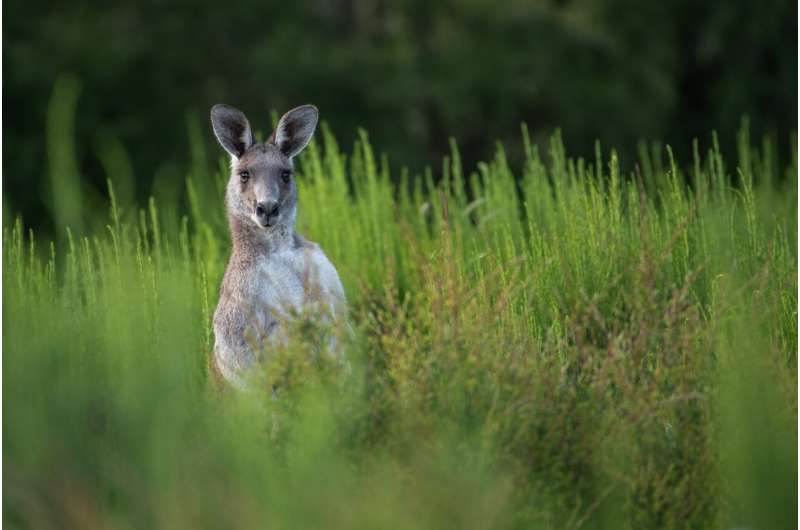This article has been reviewed according to Science X's editorial process and policies. Editors have highlighted the following attributes while ensuring the content's credibility:
fact-checked
peer-reviewed publication
trusted source
proofread
Marsupials key to discovering the origin of heater organs in mammals

Around 100 million years ago, a remarkable evolutionary shift allowed placental mammals to diversify and conquer many cold regions of our planet. New research from Stockholm University shows that the typical mammalian heater organ, brown fat, evolved exclusively in modern placental mammals. The work is published in the journal Science.
In collaboration with the Helmholtz Munich and the Natural History Museum Berlin in Germany, and the University of East Anglia in the U.K., the Stockholm research team demonstrated that marsupials, our distant relatives, possess a not fully evolved form of brown fat.
They discovered that the pivotal heat-producing protein called UCP1 became active after the divergence of placental and marsupial mammals. This finding is crucial for understanding the role of brown fat in mammalian evolution, endothermy, and metabolism.
"Our study is an important contribution to understanding the origin and regulation of brown fat," says Susanne Keipert, co-first author of the study.
"The energy-consuming function of brown fat is a major focus of medical research due to its potential to improve obesity, diabetes, and cardiometabolic diseases; all of which have reached pandemic proportions and are among the greatest threats to our health care system."
This work marks the latest milestone from the Jastroch Laboratory at Stockholm University, which has pioneered research on the evolution of mammalian heat production and integrated these evolutionary insights into understanding human metabolic diseases.
The new study shows that the marsupial UCP1 gene is actively transcribed in the adipose tissue of young opossums during a critical developmental period when they first leave their mother and experience cold stress. This is similar to birth of placental mammals, when most babies require brown fat to regulate body temperature.
During UCP1 transcription, many but not all genes commonly expressed in brown fat are present in marsupials. This indicates that marsupials do not possess the fully evolved brown adipose tissue found in placental mammals. Additionally, the heater protein UCP1 does not produce heat in marsupials, suggesting that this proto-form of brown fat lacks thermogenic function. The function of marsupial UCP1, however, still remains to be discovered.
"This evidence suggests that the gene networks required to enable thermogenesis existed before the divergence of marsupials and placental mammals. However, the pivotal UCP1 protein evolved its ability to produce heat only after the split from marsupials," explains Martin Jastroch.
Why is it important to study the mammalian family tree to decipher the origin of the brown adipose tissue?
"To find the origin of the brown fat, we cannot use a time machine. However, by examining living species that diverged at different points in evolutionary history, we can determine which have brown adipose tissue and which components of the heat-producing machinery are present. Marsupials have split from placental mammals about 120–180 million years ago. If marsupials had functional brown fat and its thermogenic protein, it would suggest that the organ existed before this split. Since it does not, it likely evolved later," says Keipert.
Using bioinformatic tools on UCP1 sequence information from many animals, the researchers reconstructed the ancient UCP1 of the stem placental mammal, as it may have existed about 110 million years ago.
They found that this ancient protein could produce heat, indicating the presence of heat-producing brown fat in the ancestor of placental mammals, but not before. This innovation likely enabled placental mammals to thrive in new cold environments.
Facts on brown fat
Brown fat is a unique heater organ in placental mammals, producing heat through a protein called uncoupling protein 1 (UCP1). The UCP1 protein transforms mitochondria into little heater units which directly convert fat and sugar into heat.
The brown fat enables newborn placental mammals, including human infants, to survive cold stress after leaving the warm womb. It helps maintain body temperature in the cold, as the immature muscle cannot sufficiently shiver.
Later in life, the brown fat can protect against metabolic complications by combusting excessive fat and sugars. Understanding how brown fat works is critical for developing therapeutic interventions for metabolic disorders.
More information: Susanne Keipert et al, Two stage evolution of mammalian adipose tissue thermogenesis, Science (2024). DOI: 10.1126/science.adg1947. www.science.org/doi/10.1126/science.adg1947
Journal information: Science
Provided by Stockholm University





















